
Transit Briefs: HART, Metra, Oregon Metro, MBTA, Metrolinx, TTC, CTA, MDOT MTA, VTA-BART
Written by Carolina Worrell, Senior Editor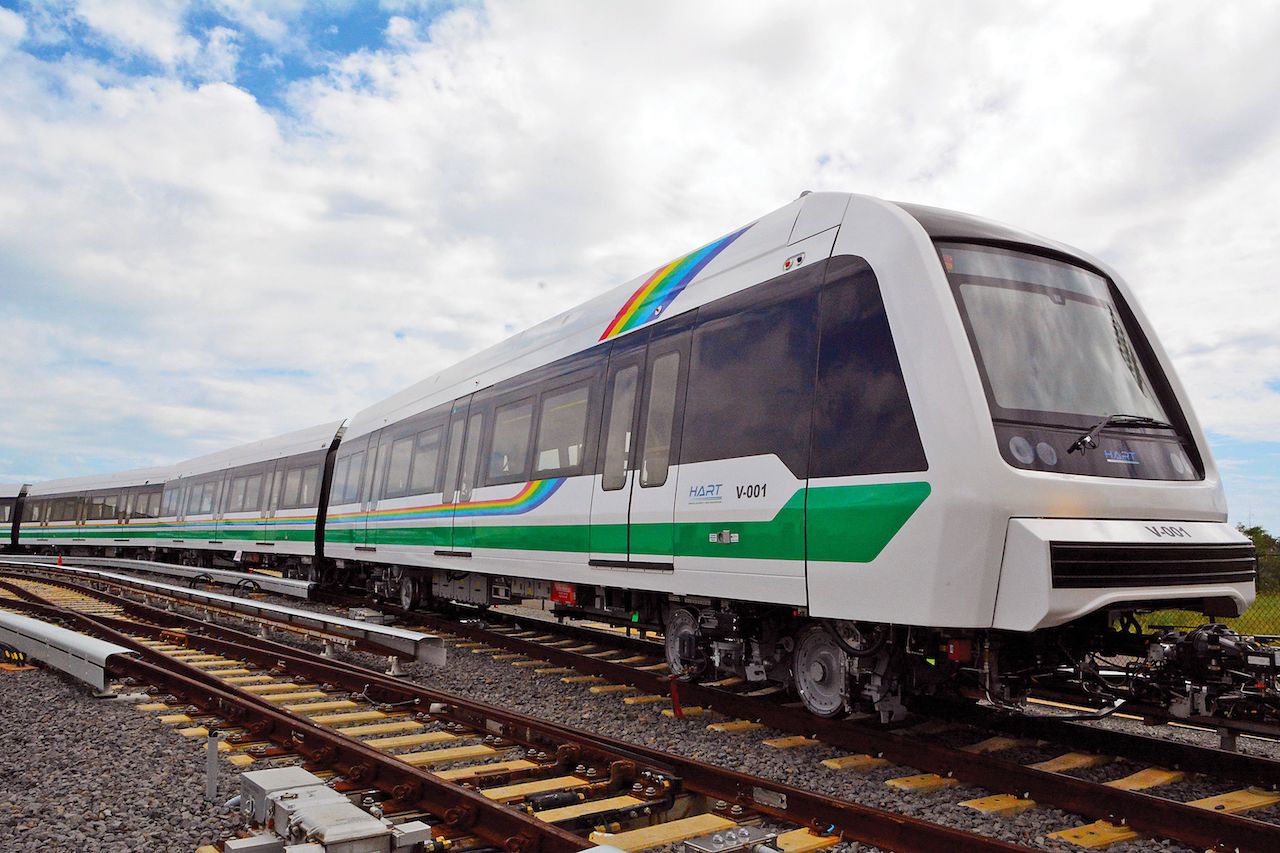
The Trial Running testing phase is the final series of testing before Honolulu's rail system goes into operation.
The Honolulu Authority for Rapid Transit (HART) announces Trial Running testing phase for the first segment of Honolulu’s rail system. Also, Metra adds service on its Union Pacific Northwest (UP-NW) Line and capacity on Metra Electric for Bike the Drive; Oregon Metro seeks proposals for 2023 Regional Transportation Plan community partnerships; Gov. Charlie Baker says Massachusetts Bay Transportation Authority (MBTA) Orange Line “on track” to finish on time; Metrolinx’s GO Train service to Niagara Falls continues year-round; The Toronto Transit Commission (TTC) increases service as more customers return to transit; Chicago Transit Authority’s (CTA) “Ask CTA” program to foster engagement with customers; The Maryland Department of Transportation (MDOT) Maryland Transit Administration (MTA) brings real-time train arrival information to Light Rail; and innovative design suggestions surface for the Santa Clara Valley Transportation Authority’s (VTA) Bay Area Rapid Transit (BART) Silicon Valley Extension Phase II project.
HART
HART announced on Aug. 30 that the Trial Running testing phase—the final series of testing before operation—for the first operating segment of Honolulu’s rail system began on Aug. 29. Trial Running, HART says, is a term to describe a “rigorous and comprehensive series of tests of all aspects of the trains, stations, systems and operating personnel, including the simulation of many normal and emergency operating scenarios.”
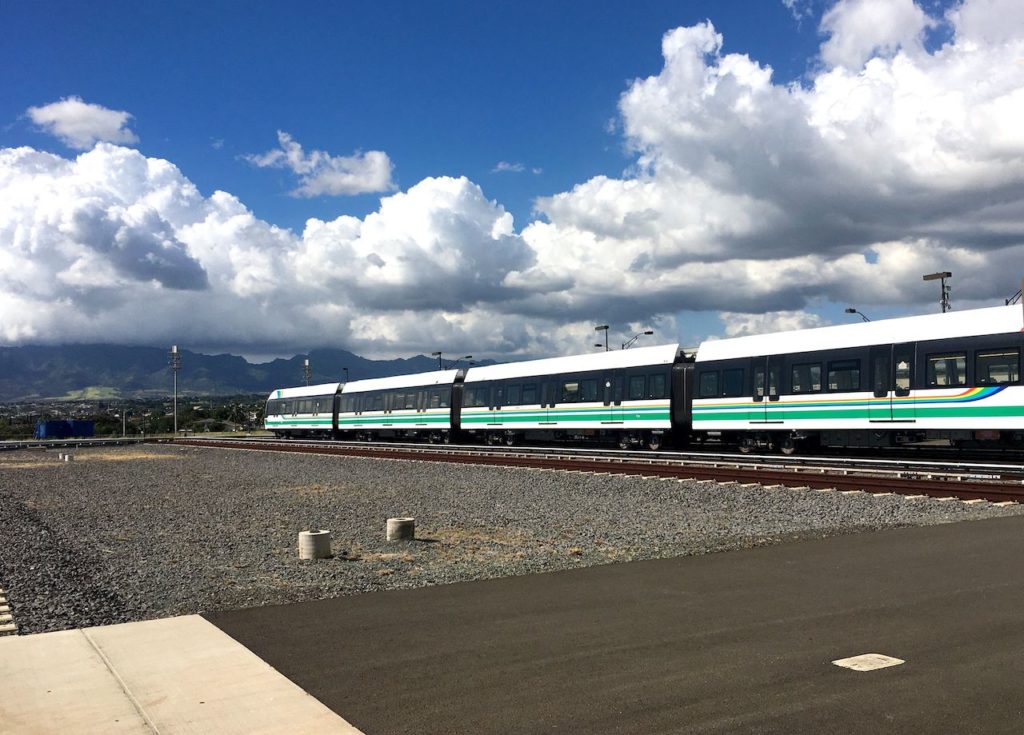
During testing, HART says, multiple trains will be operational and moving along the tracks from Kualaka‘i (East Kapolei) Station to Hālawa (Aloha Stadium) Station. Testing will occur up to 24 hours a day, seven days a week and continue until the system achieves operational readiness status, prior to the transfer of the system to City’s Department of Transportation Services (DTS) for the initial launch of service. According to HART, there is no set schedule of trains running as it will vary depending on the type of testing taking place.
According to HawaiiNewsNow, interim service is scheduled to begin to Middle Street in 2025.
“This is a major milestone for the rail project, although the larger milestone will be when trial running is complete,” said HART Executive Director and CEO Lori Kahikina. “Many tests will be performed, and we expect some problems to be encountered, which is normal for a new system and is the reason the testing is being performed.”
According to HawaiiNewsNow, some of those problems could include “cracks along the concrete guideway and faulty welds on the rail crossover, which allows the trains to switch tracks.”
HART urges the public to follow safety precautions and, when driving near the rail guideway, look ahead not overhead. The stations may look finished, HART says, but are still active construction sites throughout the testing phase. For safety purposes, the public should avoid the stations. The rail system, which is powered by a third rail that runs alongside the rail tracks and carries over 750 volts of electricity, will be live and energized throughout the testing phase. The public is urged to always avoid the rail tracks.
Metra
This year, Metra is making getting to Bike the Drive, Chicago’s largest cycling event, easier and more environmentally friendly by adding extra service and bike cars to two of its lines on Sunday, Sept. 4.
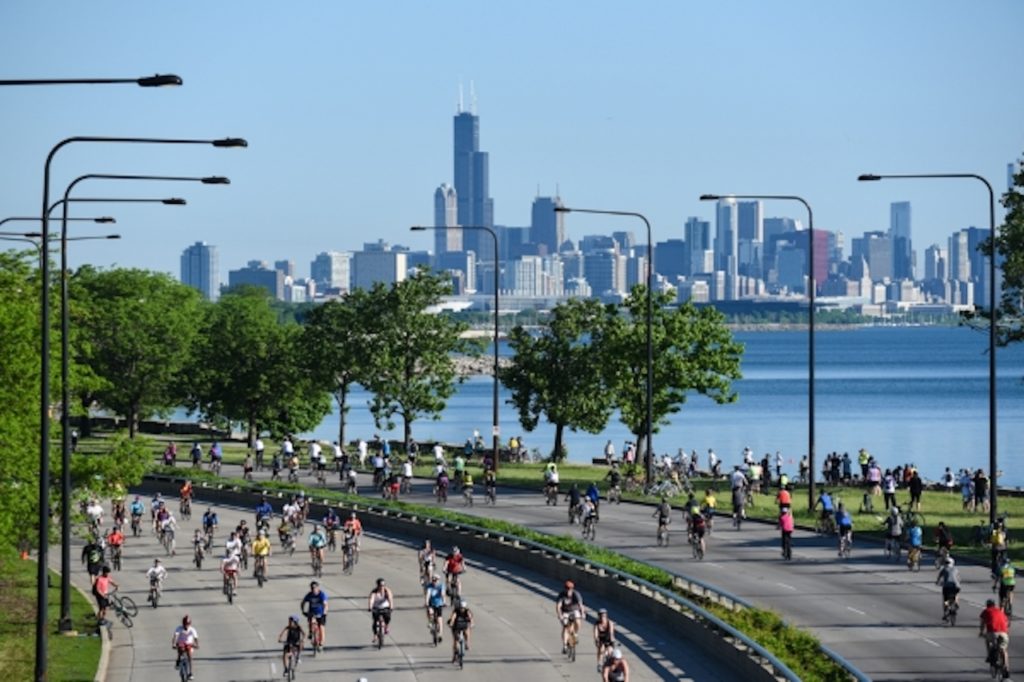
Metra will offer one extra inbound train on the UP-NW Line, departing from Crystal Lake at 5:15 a.m. and arriving in downtown Chicago at 6:40 a.m. An extra outbound train will depart from downtown’s Ogilvie Transportation Center at 1:30 p.m. Each train, Metra says, will be equipped with one bike car with 15 bike racks. These cars are in addition to the spaces in the priority seating area of each ADA-accessible railcar that can also be used to secure bicycles.
On the Metra Electric Line, at least one bike car with eight bike racks will be added to Trains 8302 and 802, in addition to the spaces in the priority seating area of the accessible cars. Train 8302 is scheduled to depart from South Chicago (93rd Street) at 5:39 a.m. and arrive at downtown’s Millennium Station at 6:16 a.m. Train 802 will depart from University Park at 5:40 a.m. and arrive at Millennium at 6:49 a.m. For the trip home, Metra Electric trains 815, 8317, 8321, and 823 will be equipped with a bike car.
“Our weekend ridership has continued to be strong as people consistently rely on us to provide a safe, reliable and affordable travel option for more than just their weekday commute,” said Metra Executive Director/CEO Jim Derwinski. “Adding service as well as a bike car on the UP Northwest Line and bike cars on the Metra Electric Line for Bike the Drive is one more way we can meet the needs of My Metra’s customers by trying a new service.”
Bike the Drive is an end of summer tradition enjoyed by thousands of Chicago area residents, Metra says. Between 6:30 a.m. and 10:30 a.m. on Sunday, Sept. 4, the northbound and southbound lanes of Jean Baptiste Point Du Sable Lake Shore Drive will be closed to cars and open to bikes. The 30-mile route, which provides a unique way to enjoy sweeping views of Lake Michigan and the city skyline, stretches from 57th Street on the city’s South Side to Hollywood Avenue on the North Side.
Funds raised through Bike the Drive benefit the Active Transportation Alliance, a non-profit advocacy organization working to improve conditions for walking, biking, and public transit throughout Chicagoland.
Oregon Metro
Oregon Metro announced on Aug. 30 that it is seeking proposals—everything from multi-media storytelling to workshops—from community organizations to engage community members in the 2023 Regional Transportation Plan (RTP), Oct. 2022 through summer 2023.
The contracts, Metro says, will “support activities that involve people of color and other communities that have been under-represented and disproportionately impacted by transportation decisions in the 2023 RTP.”
According to Metro, which has budgeted up to $120,000 for the partnership in the 2023 RTP, community input will be shared with decision makers and applied to technical work to reflect lived experiences and community priorities in the RTP. Organizations will be funded to engage community members in conversations about the transportation investments that are most needed across greater Portland.
Metro says it anticipates awarding partnership contracts up to $40,000 each. Of this $120,000, there is $40,000 dedicated to community involvement specifically in the High-Capacity Transit Strategy.
MBTA
According to CBS Boston, Massachusetts Gov. Charlie Baker “expressed confidence” that the MBTA’s Orange Line, which is currently closed for a 30-day M/W blitz, will reopen on time during a recent visit to the State Street MBTA stop. Currently, the Orange Line is schedule to reopen on Sept. 19.
“I am actually pretty confident about that, and I base that confidence on the fact that a lot of the work here can be done on a 24-hour period,” said Gov. Baker, who got a look at some of the 900 feet of new track being installed at the station and continued to point out the benefit of a full shutdown.
“You don’t have to spend hours getting onto the tracks and off of the tracks and having really limited time to actually do work,” said Gov. Baker in the CBS Boston report. “Here they can basically own the tracks 24/7. They can work on them on two shifts and dramatically speed up how long this work is going to take, which was the point of this in the first place.”
According to CBS Boston, the MBTA, which is “hoping to get five years of construction out of the way in a 30-day period,” is about a quarter of the way into the month-long shutdown and says it has completed 37% of the wok so far.
MBTA General Manager Steve Poftak added the agency was “on schedule” but not “ahead of schedule,” according to the CBS News report. “I don’t want to count these chickens before they hatch. We are on schedule; I think we are cautiously confident in our ability to do this.”
Metrolinx
Metrolinx recently announced that it will continue providing some weekend GO Train trips between Toronto’s Union Station and Niagara Falls beyond Oct. 15.
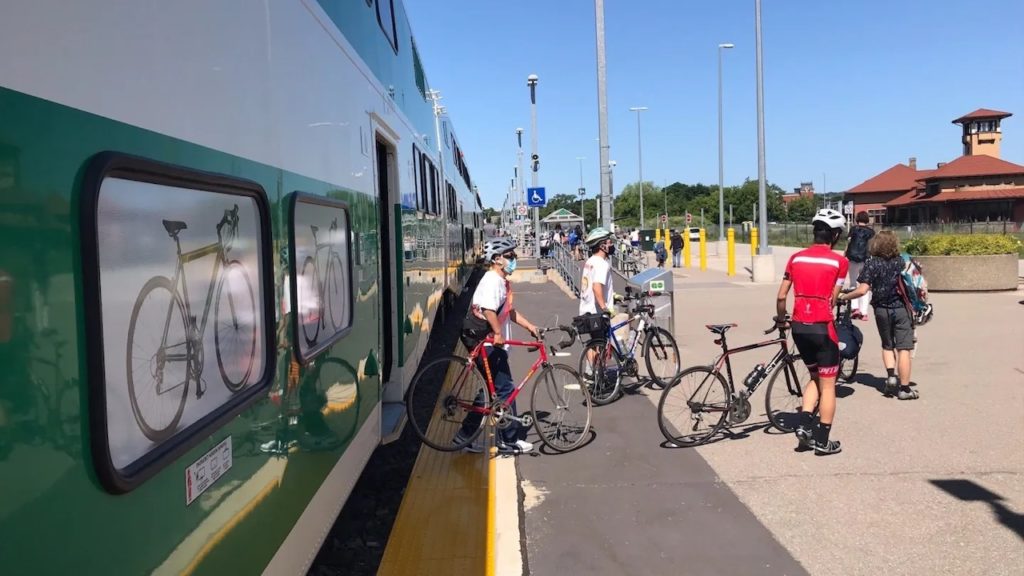
The service, which was announced by the Province last week, will include two round trips each day, offering travelers a “faster, more direct journey between downtown Toronto and Niagara Falls.”
Metrolinx says it will also continue to offer one current weekday GO Train that runs round trip from Union Station to Niagara Falls–year-round.
Additionally, Metrolinx says Niagara weekend train trips are equipped with special bike coaches, so passengers can easily bring along their bicycles and ride in comfort. Bike coaches will continue until the weather gets too cold.
Going forward, Metrolinx says it will “continue to work closely with rail partners like VIA Rail and CN freight to extend service and explore ways to improve the speed and frequency of GO Train service.”
TTC
The TTC announced on Aug. 30 that it is increasing service and taking steps to improve security and cleanliness as it prepares to welcome back more customers next week.
According to TTC, although ridership throughout the summer has been in the 55% to 60% range, current models predict a further 10% to 15% jump over the coming weeks and months, barring any new pandemic restrictions.
“As students return to school and more people return to in-office work after Labor Day, we know our ridership will increase as it typically does in September,” said TTC CEO Rick Leary. “This year is different from past years for obvious reasons. As we emerge from the COVID-19 pandemic it is especially important to me that that TTC be fully prepared to welcome everyone back to a safe and clean system with service that meets the needs of our customers.”
To ensure customers have the best experience on their return, the TTC says it has been focusing on the following four key areas:
- Increasing service across all modes and on many routes to make sure service is being delivered to meet demand and as advertised in schedules.
- Recruiting, hiring and training more frontline employees to meet these service improvements.
- Enhancing cleanliness throughout the entire system, including the hiring of 100 students to conduct a stations cleaning blitz over the summer.
- Renewing focus on safety and customer service excellence. This includes increasing the number of Special Constables and working with the city’s Streets to Home program to put resources where they are needed.
Key service changes coming into effect Sunday, Sept. 4, include:
- Restoration of three-minute train service on Lines 1 and 2.
- Increased service on 29 bus routes and two streetcar routes.
- Restoration of seasonal post-secondary services across the network. Staff worked with school boards to ensure TTC trips match planned student start and dismissal times.
- Across all modes, extra, unscheduled vehicles will be available to help fill gaps that develop due to unplanned delays or disruptions.
Later in the fall, the TTC says it will be detailing more changes and improvements to its operations, including roll out of the Automated Train Control (ATC) signaling system on all of Line 1, expansion of the Wi-Fi on buses pilot program and the introduction of a modernized fare inspection and revenue protection model.
CTA
As part of its “increased efforts to expand the dialogue with the communities it serves,” the CTA has launched a new program, titled “Ask CTA,” to connect riders with senior CTA leaders at in-person events.
The “Ask CTA” events, CTA says, will bring Authority managers from various departments to rail stations and bus transfer hubs throughout the system, where customers can ask questions and provide feedback. A Human Resources representative will also be available to provide information on many jobs available at the CTA. The effort, which launched on Aug. 30, is the latest in a series of initiatives as part of the “Meeting the Moment: Transforming CTA’s Post-Pandemic Future” Action Plan, announced earlier this month, according to CTA. Among the Plan’s five guiding pillars is improving the customer experience—and communicating with customers is key to that effort, the Authority said.
According to CTA, senior leadership will also provide updates on “Meeting the Moment,” a “comprehensive plan to improve CTA service, customer communications and the overall customer experience.” Managers from multiple CTA departments will participate, including Planning, Operations, Infrastructure, Finance, Safety/Security, Human Resources and Technology, among others.
“These senior managers are on the front lines of providing our day-to-day service, and are out on the system every day,” said CTA President Dorval R. Carter, Jr. “But these one-on-one conversations with customers will assist our managers’ efforts and help them better understand the daily experience of our riders.”
The first “Ask CTA” events will occur this week at California Blue Line (Aug. 30), 95th/Dan Ryan Red Line (Aug. 31) and Central Green Line (Sept. 1). The events will run through October and occur at three rail stations each week. The locations and times will be announced each week on CTA’s social media channels.
“The success of our Action Plan not only depends on all the things are we doing to improve customer experience, but also on being available to the communities we serve,” said Carter. “The ‘Ask CTA’ events will provide our customers a chance to speak directly with the managers responsible for diverse functions at our agency. But more importantly, it will allow us to hear directly from our customers—and use their feedback to help us further improve how we provide transit service.”
MDOT MTA
MDOT MTA announced on Aug. 30 the launch of real-time location and predicted arrival information for its Light Rail trains.
According to MDOT MTA, all fixed-route services now offer up-to-the-minute information for passengers, fulfilling a commitment the agency made to riders in its strategic plan, Rebuilding Better, released last fall. The deployment of real-time information on Light Rail, MDOT MTA says, “simplifies multi-modal travel by improving riders’ ability to plan connections to Local Bus, Metro Subway or MARC Train.”
The real-time information is available through Transit app, a free-to-download smartphone application currently used in more than 200 metropolitan areas around the world. Light rail riders can use Transit app to view train locations, predicted arrival times and step-by-step navigation. In addition, riders using the app receive alerts on service disruptions.
According to MDOT MTA, which operates Local Bus, Commuter Bus, Light RailLink, Metro SubwayLink, MARC Train Service and a comprehensive Mobility paratransit network, real-time location and predicted arrival times for the multi-modal transit system’s vehicles have “steadily expanded” since they were first introduced in June 2018 for Local Bus. The technology, MDOT MTA adds, was extended to Commuter Bus in June 2019, MARC Train in August 2020 and Metro Subway in December 2021. MDOT MTA says it continues to explore adding real-time information around the network through displays at stops and stations as part of the agency’s pledge to “provide timely, useful, clear and consistent information for riders across the system.”
“We are thrilled to expand real-time technology to our Light Rail fleet and provide riders with a better transit experience,” said MDOT MTA Administrator Holly Arnold. “Planning your Light Rail trip is easier than ever before with up-to-date information available whenever you need it.”
BART
A joint committee of VTA and BART Board members discussed at its regular meeting on Aug. 26 the “evolving design” of the six-mile, four-station Silicon Valley Extension project.
As part of the design process, VTA says, tunnel and track work contractor joint venture Kiewit Shea Traylor (KST,) is “exploring and analyzing dozens of changes that could result in more efficient delivery and ultimately enhance the project.” These ideas “take into consideration the cost and construction timeline, as well as safety, operations and maintenance, and passenger experience,” added VTA, which is building the transit extension. BART will take over after the project is completed.
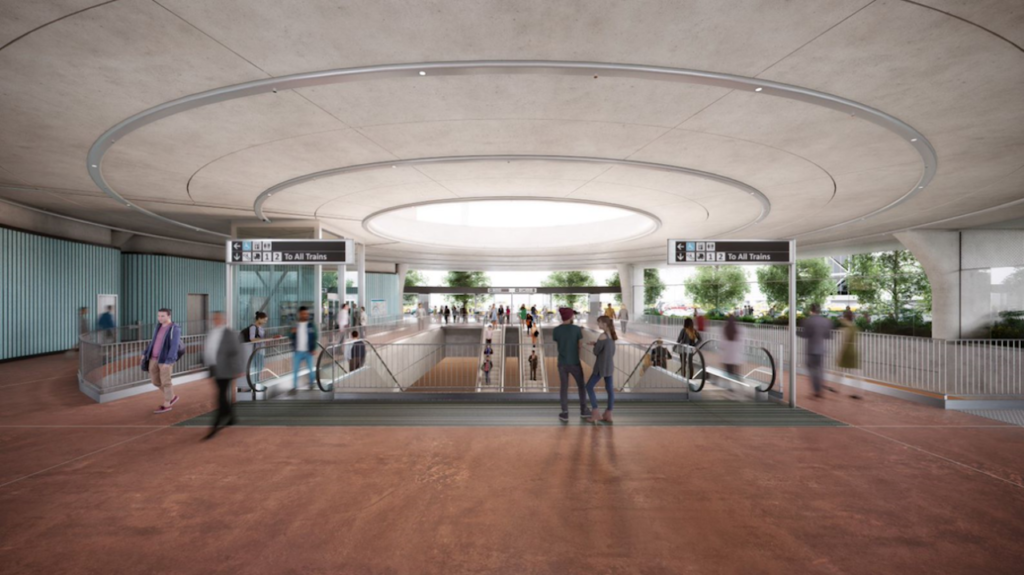
Current approved plans call for stacking two BART train platforms on top of one another inside a single, 43-foot-wide underground tunnel, the San Jose Spotlight reported. However, according to VTA, one of the new key proposed ideas includes a center boarding platform within the single bore tunnel (meaning, a platform between both directions of tracks) for all three underground stations–28th Street/Little Portugal, Downtown San Jose and Diridon Station.
This design idea would allow for:
- Side-by-side tracks for the entire six-mile extension.
- A shallower descent to the platform from the street level.
- Potential access to the boarding platforms from both sides of Santa Clara Street, in Downtown San Jose.
According to the San Jose Spotlight report, Elizabeth Chien-Hale, a board member of the San Jose Downtown Residents Association, said the “suggested changes seem like a good compromise between a single-bore tunnel with stacked platforms that VTA is pushing and the twin-bore tunnel design some transit advocates said should be built instead.”
But, whether the BART trains cruising underneath San Jose travel through one tunnel or two isn’t a done deal yet, either the San Jose Spotlight reported.
According to the San Jose Spotlight report, VTA says a single-bore tunnel will “reduce the impacts to businesses, by requiring less tearing up of streets and could also save costs by avoiding the hassle of relocating underground utilities.”
According to the San Jose Spotlight report, some critics of the project say a single-bore will “force riders to descend farther underground on elevators or escalators that could be subject to breakdown than with a twin-bore.”
According to the Authority, VTA and KST are using a delivery approach to the project that “allows for more engagement and ongoing collaboration with key stakeholders and the community as the design advances before construction begins.” During this “design innovation” period, VTA says it is working with a task force of public and private transportation professionals to identify potential station refinements. These efforts could enhance access to stations, promote Transit-Oriented Development, and spur economic growth, according to the Authority.
In a parallel effort, VTA adds that it is working with the American Public Transportation Association (APTA) to “engage an independent review of the project’s tunneling method.” Inquiries about the cutting-edge tunneling methodology, never used on a transit project in the U.S., according to VTA, spurred the review, which, according to the San Jose Spotlight report, could be ready by mid-September.
A previous independent review of the tunnel design in 2018 led to the single bore approach and current concept. The new review, VTA says, will include feedback from the ongoing “design innovation” work and build on work done to date, including the 2018 peer review.
These concurrent activities, VTA says, demonstrate the Authority’s ongoing commitment to “ensure innovative, thoughtful design, public participation and an extension that will stand the test of time as part of the largest transportation infrastructure project in Santa Clara County history.” More in-depth information on the innovations and station refinements will be shared at the VTA Board Workshop on Sept. 16.
The BART extension project, which will run from the current end of the line in Berryessa through Little Portugal at 28th Street, into downtown San Jose along Santa Clara Street, to Diridon Station and then northwest to Santa Clara, is set to cost $6.9 billion, according to VTA estimates, but federal estimates place that closer to $9.1 billion, San Jose Spotlight reported.



